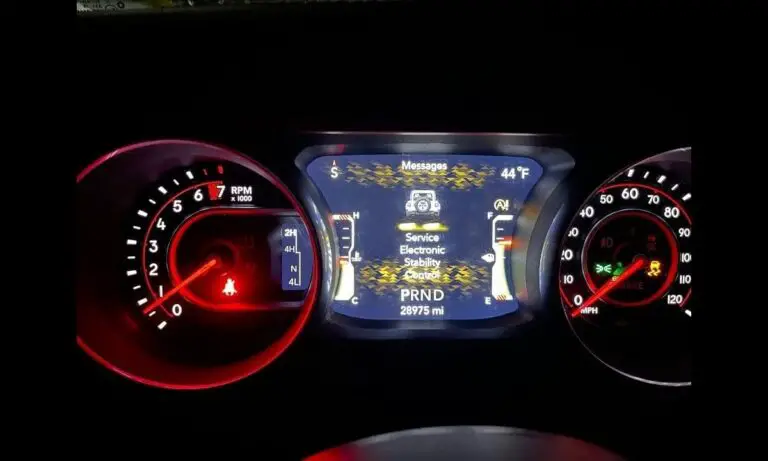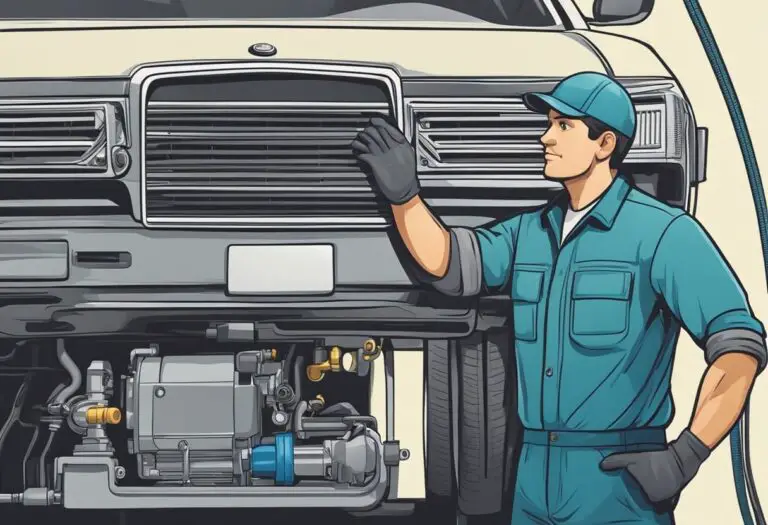Jeep P0113 Code: Troubleshoot & Fix Intake Air Temp Sensor

The dreaded Check Engine light comes on as you’re driving down the highway. You grab your scanner to pull the code and see P0113 pop up. What does this mean and what should you do?
The P0113 code indicates an issue with the intake air temperature (IAT) sensor or circuit that is causing incorrect readings. The fix usually involves inspecting the IAT sensor wiring, testing the sensor itself, and replacing components as needed.
Tracking down the cause of a Jeep P0113 code can be tricky, but this guide will walk you through the entire troubleshooting process step-by-step. We’ll cover:
- What the P0113 code means and common causes
- How to diagnose the IAT sensor and circuit
- Step-by-step IAT sensor replacement
- Repair costs, code resetting, and frequently asked questions
By the end, you’ll have the knowledge to get your Jeep’s IAT sensor functioning properly again when faced with a P0113 code.
Table of Contents
What Does the P0113 Code Mean on a Jeep?
Let’s start by decoding what the P0113 trouble code stands for.
P0113 indicates an issue with the Intake Air Temperature (IAT) Sensor Circuit.
More specifically:
- P stands for Powertrain related codes
- 0 identifies it as a fuel and air metering code
- 1 marks it as an air temperature sensor code
- 13 narrows it down to the IAT sensor
The IAT sensor measures the temperature of air entering the engine’s intake manifold. It’s a key input used by the Powertrain Control Module (PCM) to optimize fuel delivery, ignition timing, and other parameters.
When the P0113 code is triggered, it means the PCM has detected abnormal IAT readings that do not match expected values. Typically, it indicates the sensor is reading higher than normal.
Some of the most common causes behind a Jeep P0113 code include:
- Faulty or damaged IAT sensor
- Wiring damage or a loose connection
- Failed Engine Coolant Temperature (ECT) sensor resulting in incorrect data correlation
- Clogged air filter causing incorrect airflow across IAT sensor
- Intake system leaks causing unmetered air to enter
The good news is that in most cases the underlying problem is an isolated issue with the IAT sensor itself, wiring, or air filter, and not indicative of a larger engine issue.
What Are Common Causes of a Jeep P0113 Code?
Let’s take a closer look at the most prevalent issues that can trigger a Jeep P0113 Intake Air Temperature Circuit High code.
Faulty Intake Air Temperature Sensor
The IAT sensor is subject to damage from age, heat cycling, corrosion, and contamination. Over time these factors can cause the sensor to fail outright or provide inaccurate readings.
On Jeep Cherokees, the IAT sensor is often found mounted on the air ducting just after the air filter box. It’s black and roughly the size of a spark plug.
If the IAT sensor itself has failed, the only fix is to replace it with a new unit. OEM sensors from Mopar are recommended, but quality aftermarket units are available at a lower cost.
Damaged Wiring
All of the wires and electrical connections between the IAT sensor and the PCM must be intact for the sensor signal to be properly transmitted.
Common problem areas include:
- Brittle, chafed, or pinched wires
- Corrosion in connectors leading to high resistance
- Loose plugs allowing water intrusion
Carefully inspect wiring and connectors related to the IAT sensor circuit. Check for any damage, corrosion, or loose plugs that could cause an open, short, or intermittent connection.
Failed Engine Coolant Temperature Sensor
The PCM uses data from both the IAT sensor and the ECT sensor in tandem. The ECT sensor measures engine coolant temperature.
If the ECT sensor has failed, it can provide incorrect data to the PCM. This will throw off the expected correlation with IAT values and trigger a P0113 code even if the IAT sensor itself is functioning properly.
Inspect the ECT sensor and related wiring. Replace the ECT sensor if any faults are found that could be skewing the PCM’s data.
Clogged Air Filter
The IAT measures the temperature of air flowing into the engine’s intake manifold. An excessively clogged air filter will disrupt the expected airflow across the IAT sensor and result in abnormal intake air temperature readings.
Check your Jeep’s air filter. If it is extremely dirty, replace it with a new filter to restore proper airflow across the sensor.
Intake System Leaks
Any leaks in the air intake system after the mass airflow sensor can allow unmetered air to reach the engine. This will impact the correlation between the MAF sensor data and IAT values, triggering the P0113 code.
Inspect all intake components like the turbo inlet, hoses, and clamps for leaks or cracks allowing unmetered air to enter. Replace any faulty parts.
Jeep P0113 Diagnosis – How to Troubleshoot
With a basic understanding of what the P0113 code means and potential causes, you’re ready to diagnose the IAT sensor and related components on your Jeep. Here are the key troubleshooting steps:
1. Scan for Codes
Connect a scan tool and pull all diagnostic trouble codes (DTCs) stored by the PCM.
Take note of any other related codes that may indicate issues with other sensors like the MAF, MAP, or coolant temperature sensor. The existence of multiple correlated codes can help narrow down the cause.
2. Inspect IAT Sensor Wiring
Locate the IAT sensor on the intake air ductwork, usually placed after the air filter box.
Carefully inspect the connector, harness, and all visible wiring related to the IAT circuit for any damage or corrosion that could cause a faulty connection.
Look for chafed wires, bare copper, loose plugs, etc. Repair any wiring faults found.
3. Monitor IAT Sensor Data
With your scan tool, compare IAT sensor readings to the engine coolant temperature and intake air temperature data under the following conditions:
- Cold start – Values should align closely when stone cold.
- Idle when warm – Values should be within a close range.
- Light acceleration – IAT may drop slightly compared to ECT.
If data correlation is off, it points to a faulty sensor. Compare readings to repair manual specs.
4. Perform Resistance Testing
Using a digital multimeter, backprobe the IAT sensor connector and measure resistance across the sensor signal pins.
Consult a wiring diagram to identify the correct pins. Compare measured values against factory specifications. Out-of-spec readings indicate a bad IAT sensor that must be replaced.
5. Diagnose Related Components
If testing indicates the IAT sensor itself is functioning properly, expand diagnosis to related components like the ECT sensor, MAF sensor, and intake system leaks.
The issue may lie with a skewed data correlation, not the IAT sensor itself.
Following these troubleshooting steps will help accurately isolate the root cause so the correct component can be repaired to clear the P0113 code for good.
Replacing the Jeep Intake Air Temperature Sensor
Once you’ve pinpointed the IAT sensor as the culprit, replacement is straightforward:
Locate the Sensor
Consult a repair manual as the location varies by Jeep model and year. It’s typically found after the air filter box mounted to the intake ducting.
Common locations include:
- Air inlet tube
- Integrated into the MAF sensor housing
- Mounted to the fender well near the air filter box
Disconnect the Electrical Plug
The IAT sensor will have a two or three wire electrical connector. Depress the locking tab to detach the plug from the sensor.
Remove the Mounting Screw
There will either be a single screw or plastic clip securing the sensor. Remove the fastener so the sensor is loose.
Install New IAT Sensor
Align and insert the new OEM replacement sensor into the intake duct. Reinstall the mounting screw or clip to secure it in place.
Reconnect Electrical Plug
Plug the wiring harness back into the IAT sensor. Make sure it clicks into place securely.
Follow the above steps in reverse order to complete the new sensor installation. Clear any leftover P0113 codes and take a test drive to confirm normal operation.
Jeep P0113 Repair Cost
The repair cost for a Jeep P0113 code will depend on a few factors:
- Whether diagnosis indicates complete IAT sensor replacement is needed, or if it’s just a wiring repair
- Your Jeep model year – newer sensors cost more
- Shop hourly labor rate and location
Typical P0113 diagnosis and repair costs fall in the range of $150 to $250 on average.
- Diagnosis time is around 1 hour @ $100/hr
- IAT sensor replacement around 0.5 hours @ $150 parts & labor
- Minor wiring repairs 1 hour @ $100/hr
Dealerships will be at the higher end while independent shops can offer savings on labor rates. DIY repairs under $100 are possible if you can do the work yourself.
How to Reset Jeep P0113 Code?
Once the underlying issue causing the P0113 code has been resolved, you’ll need to reset the code so it clears from the PCM’s diagnostic history.
Here is the basic process:
- Complete Repairs – Make any needed sensor replacements and wiring repairs first.
- Clear Codes – Use a scan tool or disconnect the battery for 30+ minutes to clear DTCs.
- Drive Vehicle – Take a 20+ minute mixed-driving test cycle to allow the PCM to complete self-diagnostics.
- Confirm Code Cleared – Rescan PCM for any pending codes. P0113 should not reappear if fixed properly.
And that’s it! With the code reset, the check engine light will turn off and you can be on your way.
Frequently Asked Questions
What if it’s not actually the IAT sensor?
It’s possible for a P0113 to be triggered by other issues like:
- Faulty coolant temp sensor causing bad data correlation
- MAF sensor malfunction skewing expected values
- Intake leaks impacting air metering accuracy
Careful troubleshooting of related components is needed to confirm the root cause. Don’t just assume it’s the IAT sensor without proper diagnosis.
Is it safe to drive with a Jeep P0113 code?
The Jeep will usually remain drivable with a P0113 code present. However, you may notice some reduced engine performance as the PCM operates in a default mode.
Prolonged driving with any check engine light can potentially lead to further issues. Schedule repair to restore optimal engine operation and fuel economy.
Is a Jeep P0113 a serious problem?
A P0113 itself does not typically indicate a major engine issue on Jeeps. It’s usually limited to an isolated IAT sensor, wiring, or filter problem.
However, the root cause should still be repaired promptly to restore proper air metering and prevent engine damage if left unchecked long term.
Conclusion
Finding the cause of a Jeep P0113 intake air temperature sensor code doesn’t have to be a painful process. Following the diagnostic, troubleshooting, and repair steps outlined in this article will get your Jeep back to running smoothly in no time.
The key takeaways are:
- Use wiring diagrams to inspect connections and test sensor resistance
- Compare IAT correlations to pinpoint the faulty component
- Replace the IAT sensor or make wiring repairs as needed
- Reset codes only after the root cause is fixed
Equipped with the information in this guide, you can have confidence tackling a P0113 code DIY-style in your garage or discussing repairs with your mechanic. Your check engine light will be off and Jeep riding great once the pesky IAT sensor gremlin is addressed properly.







